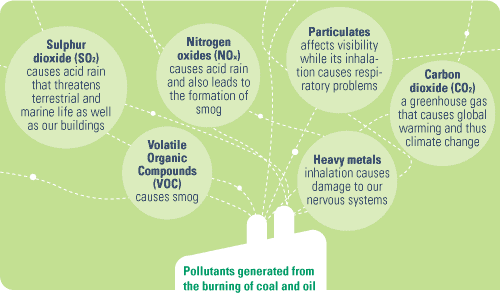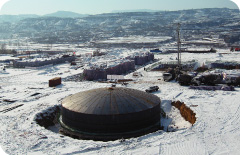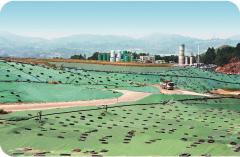Energy is essential both to sustain life and to enhance economic development. Over the years, mankind has come to rely on coal and oil as the major sources of energy. Unfortunately, their unrestricted use both depletes world resources and generates environmental pollution. Aware of the need to generate energy while simultaneously protecting the environment, we are actively exploring the use of clean energy.

One of the major problems we are facing is climate change. Scientists tell us that the world is getting warmer due to the increased burning of natural resources for energy and the resulting emission of greenhouse gases. The demand for energy is growing – according to the International Energy Agency, demand will grow 60% by 2030. Only when we know how these global energy needs will be met, will we be able to determine whether climate change will remain manageable.
Cleaner Feedstock for Town Gas Production in Hong Kong
From coal to naphtha

From naphtha to natural gas
Natural gas, one of the cleanest forms of fossil fuels, is a colourless and odourless combustible gas found in gas and oil fields. It is primarily made up of methane. When burnt, less CO2, SO2 and NOx emissions are produced and when released into the atmosphere, it dissipates rapidly as it is lighter than air. The natural gas we use comes from Northwestern Australia though there are abundant reserves of natural gas in many parts of the world, including Russia, Australia, China and Indonesia.
The introduction of natural gas into the town gas production process was a complex business. It involved comprehensive technology research, planning, environmental impact assessments as well as the construction of relevant facilities under stringent environmental protection specifications.
To facilitate transportation, the natural gas is liquefied at a temperature of -162°C before being transported by special tankers from Northwestern Australia to the liquefied natural gas (LNG) receiving terminal in Chengtaojiao in Shenzhen. The liquefied gas then goes through a gasification process before being delivered to our gas production plant in Tai Po, via a pair of 34 km high-pressure submarine pipelines. At the Tai Po plant, the modified gas production units use the LNG as feedstock for the manufacturing of town gas.

Natural Gas Utilisation and Other Initiatives in Mainland China
Our natural gas development on the mainland scaled new peaks in 2007, with the establishment of our first energy exploitation joint venture in the early part of the year in Jilin province. Our midstream energy projects include high-pressure natural gas pipeline joint ventures in Anhui province, Hebei province and Hangzhou, Zhejiang province, and a new joint venture invests in the construction of natural gas pipelines and the exploitation of crude oil in Jilin province. These projects underpin our downstream joint venture projects, enabling us to strengthen natural gas development in the regions concerned.Following the acquisition of Panva Gas, as an associated company in early March 2007, our piped city-gas projects increased to 65 in mainland cities spread across 14 provinces and municipalities. Gas sales reached 4.6 billion cubic metres, an increase of 2.5 billion cubic metres over 2006. This widespread use of clean gas instead of diesel and coal is helping to build clean cities.
In 2006, making use of the huge coal reserves in Shanxi province, a JV was set up to turn coal-bed methane into a liquefied natural gas equivalent. The liquefaction plant is now under construction and is expected to come into operation in 2008.
In view of the vast reserves of coal on the mainland, we are aggressively exploring opportunities with regard to the production of methanol and dimethylether (DME) using coal as feedstock. Through blending or direct substitution, Methanol and DME can be used as alternative transportation fuels to both gasoline and diesel. Methanol can also be used as a feedstock in the chemical industry, which is currently dominated by petroleum-based products. The production of methanol and DME also enables the much cleaner use of coal as an energy source since waste can be more readily captured and recycled. This emerging energy initiative is expected to create strong environmental benefits for the mainland.


Landfill Gas Utilisation in Hong Kong
We also recover useful energy from municipal waste through the use of landfill gas (LFG). Methane is captured from landfill gas and processed into a heating fuel for town gas production. The benefits are twofold, it not only reduces the flaring of landfill gas, which generates CO2, it also reduces the consumption of naphtha as a fuel. With the commencement of our first LFG project at Shuen Wan Landfill in 1999, we have been able to reduce CO2 emissions of approximately 5,400 metric tonnes a year in the gas production process for the past seven years. Building on this success, we launched a second LFG project at the Northeast New Territories (NENT) landfill site in 2004. This LFG NENT project was commissioned in 2007. One of the largest in the world, it is expected to reduce up to 135,000 metric tonnes of CO2 annually.


























